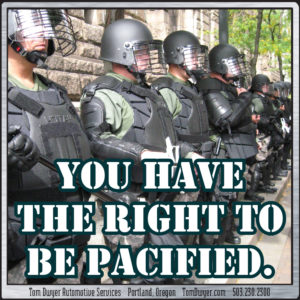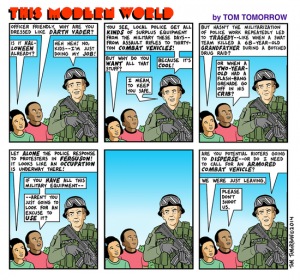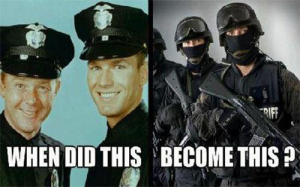Police Militarization
 There’s an old theater saying that if there’s a gun on the mantle in a play’s first act, it will be used by the third act. For years, police around the country have been stocking their mantles with body armor, batons, tear gas, shotguns, automatic weapons, and armored vehicles. The Battle in Seattle, Occupy, Ferguson, and thousands of smaller, unnamed actions around the country are sounding a loud warning… the mantle is full, and the third act in this drama could be pretty ugly.
There’s an old theater saying that if there’s a gun on the mantle in a play’s first act, it will be used by the third act. For years, police around the country have been stocking their mantles with body armor, batons, tear gas, shotguns, automatic weapons, and armored vehicles. The Battle in Seattle, Occupy, Ferguson, and thousands of smaller, unnamed actions around the country are sounding a loud warning… the mantle is full, and the third act in this drama could be pretty ugly.
Poverty, racism, corruption and more were on full display in Ferguson last month. These issues are all inextricably linked, and combined form a broken system that at best doesn’t serve, and at worst preys upon, people who have no option but to deal with it. From this tangled mess of civic collapse we pulled one thread to look at in more detail this month, one that we all face regardless of race, economic status, or location… the problem of Police Militarization.
 Our current system of policing is built on the ideas of Sir Robert Peel and the principles he established for an ethical police force. His concepts have been described as “unique in history and throughout the world, because it derived, not from fear, but almost exclusively from public co-operation with the police, induced by them designedly by behavior which secures and maintains for them the approval, respect and affection of the public”. Peel believed the police were inextricable parts of the community, and that this connection gave them their strength. Increasing police militarization is endangering that foundational concept. Aside from the equipment that inherently separates police from their community, current police culture has moved to an “us vs. them” format that views citizens as an enemy to be defended against.
Our current system of policing is built on the ideas of Sir Robert Peel and the principles he established for an ethical police force. His concepts have been described as “unique in history and throughout the world, because it derived, not from fear, but almost exclusively from public co-operation with the police, induced by them designedly by behavior which secures and maintains for them the approval, respect and affection of the public”. Peel believed the police were inextricable parts of the community, and that this connection gave them their strength. Increasing police militarization is endangering that foundational concept. Aside from the equipment that inherently separates police from their community, current police culture has moved to an “us vs. them” format that views citizens as an enemy to be defended against.
Police militarization is a huge issue. It has many contributing factors that can’t be teased apart, and these complex motivations mean the issue will continue for a long time to come. However, we assembled some of the best insights we’ve been able to find in the wake of Ferguson. We hope they can give you a broader perspective on the police and the problems we all face as we try to better define their role in our communities and our lives. And, surprisingly, you’ll see several options for what we as citizens can do about this problem.
Overview
First, here are a couple articles that describe the shape and extent of the militarization problem
- War Comes Home: The Excessive Militarization of American Policing, ACLU
- 11 Shocking Facts About America’s Militarized Police Forces, Alex Kane, AlterNet
Much of the problem with militarized police is the face it presents to citizens.
- VIDEO: Introduction to Police Militarization by Brave New Films
- These images from Ferguson show what it was like from the protesters point of view.
- Exclusive Video: This Is How Police Treated Residents of the Apartment Complex Where Michael Brown Was Killed Steven Hsieh, The Nation
What kind of weapons are we talking about, where are they coming from, and where are they going?
- Iraq Vet: Small-Town Cops Have Better Armor and Weaponry Than We Carried in a Combat Moyers & Company
- Why America’s police forces look like invading armies Amanda Taub on Vox
- Mapping the Spread of the Military’s Surplus Gear New York Times
Why is this happening?
- The Literal War on Drugs Jacob Sullum, Reason.com
- New Video Explains How Cops Became Soldiers, Saki Knafo, Huffington Post
- 4 Weird Decisions That Have Made Modern Cops Terrifying, JF Sargent and Billy Anderson, Cracked
Opinions from talking heads and public officials
- Military veterans see deeply flawed police response in Ferguson Thomas Gibbons-Neff, Washington Post
- Why You Shouldn’t Trust Right-Wingers’ Sudden Concern About the Police Heather Digby Parton, AlterNet
- This Is The Terrifying Result Of The Militarization Of Police, Paul Szoldra, Business Insider
- A Matter of Life and Death: The Danger of an Out-of-Control State, Norm Ornstein, The Atlantic
- Officer Friendly Is the Policeman of the Past — Now They Look Like Navy Seals, Jim Hightower, AlterNet
- Will the Growing Militarization of Our Police Doom Community Policing?, Carl Bickel, Community Policing Dispatch
- Rand Paul Calls For Demilitarization Of Police After Ferguson Shooting
- Rand Paul: Scene in Ferguson Resembles “War More Than Traditional Police Action”
- Dem pushes Ferguson machine gun bill
- Debate over police militarization to begin in earnest Steve Benen, MSNBC
- Obama orders review of military equipment supplied to police Mario Trujillo, The Hill
Militarization around the country
It’s not like Ferguson was an isolated incident. Here are stories from around the country of SWAT and Police going way over the line. Unfortunately, it’s too easy to find many, many more.
- The Day Ferguson Cops Were Caught in a Bloody Lie Michael Daly, The Daily Beast Note: This is the appalling story about a Fergusonian who, beaten in custody, was charged with bleeding on the uniforms of the cops who beat him.
- “They didn’t have any reason to, but they hit my nephew in the head with their rifle. He’s 13″ Free Thought Project
- Indiana grandmother suffers violent SWAT raid after a neighbor uses her wireless internet PoliceStateUSA
- VIDEO- 4:24 of cops openly beating, kicking, punching, spraying, and otherwise assaulting (in most cases) unresisting people. Very difficult to watch.
- VIDEO- Cops Tase and Arrest Man for Sitting and Not Stating His Name Arturo Garcia on AlterNet
- Cops Beating Suspect During Arrest At Walmart, The Young Turks
- VIDEO: Deputies Throw Paralyzed Man From His Wheelchair Information Clearing House
- Black Children as Young as Kindergarteners Are Getting Hand-Cuffed and Arrested Across the US, Margaret Kimberly, AlterNet
- Police Shoot 95-Year-Old WWII Vet to Death for Refusing to Go to Hospital, Jack Bouboushian, AlterNet
- A SWAT Team Blew a Hole in My 2-Year-Old Son, Alecia Phonesavanh, AlterNet
- NYPD Continues Tradition Of Police Brutality, Chariese Elizabeth, Ring of Fire Radio
- TV & Film Producer Arrested For Being Black In Beverly Hills, Charles Belk, Liberals Unite
- Georgia cops fired Taser 13 times ‘as a cattle prod’ to make tired man walk before he died, David Edwards, Raw Story
- Police Shot Texas Man So Many Times ‘He Had No Face’, John Prager, Crooks and Liars
- NYPD Pays $33K to Settle Suit After Mistaking Jolly Ranchers for Meth, Aleksander Chan, Gawker
Police attitude matters in every interaction from a traffic ticket to a potential riot situation. Tensions in Ferguson ratcheted down when Captain Ronald Johnson and the Missouri State Police took over security from the locals. What was Capt. Johnson’s attitude toward policing? “When I see a young lady cry because of fear of this uniform, that’s a problem. We’ve got to solve that,” Johnson said.
More on how a change in attitude affected the situation on the ground…
What’s coming next?
- Militarized cops’ scary new toys: The ugly next frontier in “crowd control” Heather Digby Parton, Salon
- The Pentagon’s Ray Gun, 60 Minutes
- Texas Schools Arming Campus Cops With Surplus Military Weapons, Amy Eddings, Ring of Fire Radio
- Massachusetts SWAT teams claim they’re private corporations, immune from open records laws, Radley Balko, Washington Post
What can we do to end this?
- How to End Militarized Policing Alex Vitale, The Nation
- Could the Ferguson Conflict Produce Actual Reform on the Limits of Policing? Moyers & Company
- Sign petition to Chuck Hagel: Suspend the Weapons Transfer Program that is Militarizing Police
- Grassroots Resistance as ‘Police Militarization’ Expo Descends on Oakland, Sarah Lazare, Common Dreams
- Militarization, Surveillance, and Profit: How Grassroots Groups are Fighting Urban Shield, Nadia Kayyali, Common Dreams
- Make cops wear cameras!
- California police use of body cameras cuts violence and complaints, Rory Carroll in the Guardian
- Will Forcing Cops to Wear Body Cameras Quell Brutality?
- If all Cops used these New Devices, there would be a Dramatic Decrease in Police Brutality Matt Agorist, The Free Thought Project
- Indiana grandmother suffers violent SWAT raid after a neighbor uses her wireless internet, Police State USA “Interestingly, both the plaintiffs and defendants believe the video helps their case. The Milans believe the video shows officers acting negligently and violating their constitutional rights, and the government believes the officers were shown to be “respectful” to the women — after pointing rifles at them and breaking their stuff.”










